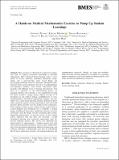| dc.contributor.author | Pennes, Anthony | |
| dc.contributor.author | Mendez, Keegan | |
| dc.contributor.author | Hanumara, Nevan | |
| dc.contributor.author | Roche, Ellen T. | |
| dc.contributor.author | Traverso, Giovanni | |
| dc.contributor.author | Custer, David | |
| dc.contributor.author | Hom, Gim | |
| dc.date.accessioned | 2023-01-23T13:51:13Z | |
| dc.date.available | 2023-01-23T13:51:13Z | |
| dc.date.issued | 2023-01-19 | |
| dc.identifier.uri | https://hdl.handle.net/1721.1/147627 | |
| dc.description.abstract | Abstract
Best practices in Biomedical Engineering education seek to connect classroom knowledge to practical applications. MIT’s Medical Device Design course is comprised of in-class didactics, individual laboratory assignments, and a semester-long, team- based design and prototyping challenge, based in real unmet biomedical need. Students in the course represent a broad set of undergraduate and graduate students, from diverse educational backgrounds, with different levels of training and expertise. This year, as a precursor to the semester-long project, we designed, piloted, and evaluated a new experiential learning lab based around a syringe pump, selected because of its prevalence in the clinical setting, exemplification of core, multidisciplinary biomedical engineering concepts, and suitability for a team-based learning exercise. Students individually calculated patient dosing requirements and translated desired volume and flow rate into stepper motor commands. Then, during a single in-class session, teams worked from a custom-designed and fabricated kit to assemble a syringe pump, breadboard electronics, implement software controls, and finally close the design loop by evaluating their pumps' dispensing performance. A post-lab survey of the student cohort indicated that this pilot lab provided a sound biomedical learning and teamwork opportunity that improved technical literacy. The survey also identified key opportunities for improvement – students wanted more time and instructor-guided learning to increase their understanding of the mechanical engineering, electrical engineering, and software subtopics. Consequently, next year we will expand the lab into a multi-class exercise, with enhanced lectures and supplementary materials. Overall, we share this problem-based learning exercise, designed to exemplify key concepts, improve teamwork, and foster hands-on tinkering skills, with other biomedical engineering instructors. | en_US |
| dc.publisher | Springer International Publishing | en_US |
| dc.relation.isversionof | https://doi.org/10.1007/s43683-022-00100-4 | en_US |
| dc.rights | Creative Commons Attribution | en_US |
| dc.rights.uri | https://creativecommons.org/licenses/by/4.0/ | en_US |
| dc.source | Springer International Publishing | en_US |
| dc.title | A Hands-on Medical Mechatronics Exercise to Pump Up Student Learnings | en_US |
| dc.type | Article | en_US |
| dc.identifier.citation | Pennes, Anthony, Mendez, Keegan, Hanumara, Nevan, Roche, Ellen T., Traverso, Giovanni et al. 2023. "A Hands-on Medical Mechatronics Exercise to Pump Up Student Learnings." | |
| dc.contributor.department | Massachusetts Institute of Technology. Department of Electrical Engineering and Computer Science | |
| dc.contributor.department | Massachusetts Institute of Technology. Institute for Medical Engineering & Science | |
| dc.contributor.department | Massachusetts Institute of Technology. Department of Mechanical Engineering | |
| dc.identifier.mitlicense | PUBLISHER_CC | |
| dc.eprint.version | Final published version | en_US |
| dc.type.uri | http://purl.org/eprint/type/JournalArticle | en_US |
| eprint.status | http://purl.org/eprint/status/PeerReviewed | en_US |
| dc.date.updated | 2023-01-22T04:15:16Z | |
| dc.language.rfc3066 | en | |
| dc.rights.holder | The Author(s) | |
| dspace.embargo.terms | N | |
| dspace.date.submission | 2023-01-22T04:15:16Z | |
| mit.license | PUBLISHER_CC | |
| mit.metadata.status | Authority Work and Publication Information Needed | en_US |
